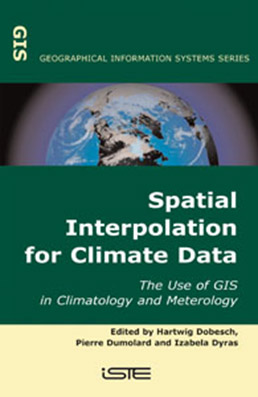
Edited by
Hartwig Dobesch, Institute of Meteorology and Geodynamics, Vienna, Austria
Pierre Dumolard, Joseph Fourier University, Grenoble, France
Izabela Dyras, Institute of Meteorology and Water Management, Krakow, Poland
This title gives an authoritative look at the use of Geographical Information Systems (GIS) in climatology and meteorology. GIS provides a range of strategies, from traditional methods, such as those for hydromet database analysis and management, to new developing methods. As such, this book will provide a useful reference tool in this important aspect of climatology and meteorology study.
Part 1. GIS to manage and distribute climate data
1. GIS, climatology and meteorology
2. SIGMA: a web-based GIS for environmental applications.
3. Web mapping: different solutions using GIS.
4. Comparison of geostatistical and meteorological interpolation methods.
5. Uncertainty from spatial sampling: a case study in the French Alps.
Part 2. Spatial interpolation of climate data
6. The developments in spatialization of meteorological and climatological elements.
7. The spatial analysis of selected meteorological fields in the example of Poland.
8. Optimizing the interpolation of temperatures by GIS: a spatial analysis approach.
9. Daily winter air temperature mapping in mountainous areas.
10. Aspects concerning the spatialization of radiation balance components.
Part 3. Demo projects
11. The use of GIS applications in meteorology and climatology: a need for the application of regional ecological modeling approaches.
12. GIS application to daily fire risk mapping.
13. Application of GIS technology on the comparisons of climatological databases: an overview of winter precipitation over Spain.
14. Drought sensitivity research in Hungary and influence of climate change on drought sensitivity.
15. First steps towards a new temperature climatology of the Greater Alpine Region (GAR)
16. XRWIS: a new GIS paradigm for winter road maintenance.
Part 4. Climate-related applications
17. The use of GIS in climatology: challenges in fine scales applications: examples in agrometeorological and urban climate studies.
18. Climate impact on winter land use and land cover management in Brittany.
19. A tool for the integrated use of remote sensing with ground truth data: Demeter project.
20. Assessing population exposure to odorous pollution from a landfill over complex terrain.
21. Disaggregated estimation of N2O fluxes from agricultural soils of the italian region by modelization in a GIS environment
Hartwig Dobesch is professor, specialised in meteorology and climatology, at the Institute of Meteorology and Geodynamics of Vienna. He is, among other tasks, promoter and president of the COST 719 european research program "the use of GIS in climatology and meteorology"
Pierre Dumolard is emeritus professor of GIS and spatial analysis at the Joseph Fourier university of Grenoble. He is the coordinator of the "Traité IGAT" (32 books in french on GIS and their applications, Hermes Science Publishing).
Izabela Dyras is the leader of the Satellite Research Department in the Institute of Meteorology and Water Management of Krakow. She is the vice-president of the COST european research program "The use of GIS in climatology & meteorology".